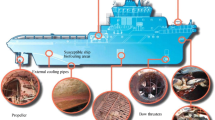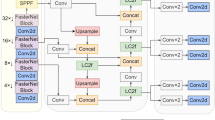Abstract
It is efficient to replace human eyes with underwater vehicles equipped with visual sensors to carry out underwater inspections. However, the inability of monocular vision to provide accurate depth information highlights the importance of binocular vision in underwater target detection and measurement. In this paper, an ROV (Remotely Operated Vehicles) based binocular vision system incorporating a specially designed underwater robot is developed to carry out underwater structure detection in real-time. The system is designed to adapt to long-distance and long-duration underwater missions in various underwater environments. Taking cracks as inspection targets, a crack detection and measurement approach is proposed after the robot’s surface cleaning function is applied. Firstly, an affine transformation model is used to enhance the color-distorted underwater images effectively. Then, the multi-directional gray-level fluctuation analysis is applied to acquire an accurate crack segmented result. Finally, the computed disparity map is combined with the segmentation map to determine the crack width quickly. A group of experiments is performed and the validity and effectiveness of the system and crack measurement algorithm are demonstrated.

















Similar content being viewed by others
Data availability
Data underlying the results presented in this paper are not publicly available at this time but may be obtained from the authors upon reasonable requests.
Code availability
Our code will be open source in the future.
References
Alipour M, Harris DK, Miller GR (2019) Robust pixel-level crack detection using deep fully convolutional neural networks. J Comput Civ Eng 33:04019040. https://doi.org/10.1061/(asce)cp.1943-5487.0000854
Cha YJ, You K, Choi W (2016) Vision-based detection of loosened bolts using the Hough transform and support vector machines. Autom Constr 71:181–188. https://doi.org/10.1016/j.autcon.2016.06.008
Cha YJ, Choi W, Büyüköztürk O (2017) Deep learning-based crack damage detection using convolutional neural networks. Comput Civ Infrastruct Eng 32:361–378. https://doi.org/10.1111/mice.12263
Chen Z, Zhang Z, Dai F, Bu Y, Wang H (2017) Monocular vision-based underwater object detection. Sensors (Switzerland) 17:1784. https://doi.org/10.3390/s17081784
Cho H, Yoon HJ, Jung JY (2018) Image-based crack detection using crack width transform (CWT) algorithm. IEEE Access 6:60100–60114. https://doi.org/10.1109/ACCESS.2018.2875889
Choi JK, Yokobiki T, Kawaguchi K (2018) ROV-based automated cable-laying system: application to DONET2 installation. IEEE J Ocean Eng 43:665–676. https://doi.org/10.1109/JOE.2017.2735598
Collings S, Martin TJ, Hernandez E, Edwards S, Filisetti A, Catt G, Marouchos A, Boyd M, Embry C (2020) Findings from a combined subsea LiDAR and multibeam survey at Kingston reef, Western Australia. Remote Sens 12:2443. https://doi.org/10.3390/RS12152443
Feng C, Zhang H, Wang H, Wang S, Li Y (2020) Automatic pixel-level crack detection on dam surface using deep convolutional network. Sensors (Switzerland) 20:2069. https://doi.org/10.3390/s20072069
Gong Z, Li C, Jiang F (2020) A machine learning-based approach for auto-detection and localization of targets in underwater acoustic Array networks. IEEE Trans Veh Technol 69:15857–15866. https://doi.org/10.1109/TVT.2020.3036350
Gottsäter E, Johansson M, Plos M, Larsson Ivanov O (2019) Crack widths in base restrained walls subjected to restraint loading. Eng Struct 189:272–285. https://doi.org/10.1016/J.ENGSTRUCT.2019.03.089
Hachicha S, Zaoui C, Dallagi H, Nejim S, Maalej A (2019) Innovative design of an underwater cleaning robot with a two arm manipulator for hull cleaning. Ocean Eng 181:303–313. https://doi.org/10.1016/j.oceaneng.2019.03.044
Hassan N, Ullah S, Bhatti N, Mahmood H, Zia M (2021) The Retinex based improved underwater image enhancement. Multimed Tools Appl 80:1839–1857. https://doi.org/10.1007/S11042-020-09752-2
Hong S, Kim J (2020) Three-dimensional visual mapping of underwater ship Hull surface using piecewise-planar SLAM. Int J Control Autom Syst 18:564–574. https://doi.org/10.1007/S12555-019-0646-8
Huang D, Wang Y, Song W et al (2018) Shallow-water image enhancement using relative global histogram stretching based on adaptive parameter acquisition. In: lecture notes in computer science (including subseries lecture notes in artificial intelligence and lecture notes in bioinformatics). Springer Verlag, pp 453–465. https://doi.org/10.1007/978-3-319-73603-7_37
Huang Z, Wan L, Sheng M et al (2019) An underwater image enhancement method for simultaneous localization and mapping of autonomous underwater vehicle. In: proceedings of 2019 3rd IEEE international conference on robotics and automation sciences, ICRAS 2019. Institute of Electrical and Electronics Engineers Inc., pp 137–142. https://doi.org/10.1109/ICRAS.2019.8809014
Islam MJ, Xia Y, Sattar J (2020) Fast underwater image enhancement for improved visual perception. IEEE Robot Autom Lett 5:3227–3234. https://doi.org/10.1109/LRA.2020.2974710
Jin S, Lee SE, Hong JW (2020) A vision-based approach for autonomous crack width measurement with flexible kernel. Autom Constr 110:103019. https://doi.org/10.1016/j.autcon.2019.103019
Kot P, Muradov M, Gkantou M, Kamaris GS, Hashim K, Yeboah D (2021) Recent advancements in non-destructive testing techniques for structural health monitoring. Appl Sci 11:1–28. https://doi.org/10.3390/APP11062750
Li CY, Guo JC, Cong RM, Pang YW, Wang B (2016) Underwater image enhancement by Dehazing with minimum information loss and histogram distribution prior. IEEE Trans Image Process 25:5664–5677. https://doi.org/10.1109/TIP.2016.2612882
Li S, Yang W, Xu L, Li C (2019) An environmental perception framework for robotic fish formation based on machine learning methods. Appl Sci 9:3573. https://doi.org/10.3390/APP9173573
Li L, Zhang H, Pang J, Huang J (2019) Dam surface crack detection based on deep learning. In: ACM International Conference Proceeding Series. Association for Computing Machinery, pp 738–743. https://doi.org/10.1145/3366194.3366327
Lu P, Liu Q, Guo J (2016) Camera calibration implementation based on zhang zhengyou plane method. In: Lecture Notes in Electrical Engineering https://doi.org/10.1007/978-3-662-48386-2_4
Marques TP, Branzan Albu A (2020) L2UWE: a framework for the efficient enhancement of low-light underwater images using local contrast and multi-scale fusion. In: IEEE Computer Society Conference on Computer Vision and Pattern Recognition Workshops https://doi.org/10.1109/CVPRW50498.2020.00277
Muhammad N, Fuentes-Perez JF, Tuhtan JA, Toming G, Musall M, Kruusmaa M (2019) Map-based localization and loop-closure detection from a moving underwater platform using flow features. Auton Robot 43:1419–1434. https://doi.org/10.1007/s10514-018-9797-3
Muñoz F, Cervantes-Rojas JS, Valdovinos JM, Sandre-Hernández O, Salazar S, Romero H (2021) Dynamic neural network-based adaptive tracking control for an autonomous underwater vehicle subject to modeling and parametric uncertainties. Appl Sci 11:2797. https://doi.org/10.3390/APP11062797
Nasr A, Kjellström E, Björnsson I, Honfi D, Ivanov OL, Johansson J (2020) Bridges in a changing climate: a study of the potential impacts of climate change on bridges and their possible adaptations. Struct Infrastruct Eng 16:738–749. https://doi.org/10.1080/15732479.2019.1670215
Nhat-Duc H, Nguyen QL, Tran VD (2018) Automatic recognition of asphalt pavement cracks using metaheuristic optimized edge detection algorithms and convolution neural network. Autom Constr 94:203–213. https://doi.org/10.1016/j.autcon.2018.07.008
Nowald N, Ratmeyer V, Wefer G (2016) MARUM-Squid - A powerful, yet compact 2000 m ROV system designed for marine research operations from smaller vessels. OCEANS 2016 MTS/IEEE Monterey 1–4. https://doi.org/10.1109/OCEANS.2016.7761353.
Palomer A, Ridao P, Ribas D (2019) Inspection of an underwater structure using point-cloud SLAM with an AUV and a laser scanner. J F Robot 36:1333–1344. https://doi.org/10.1002/rob.21907
Peng X, Zhong X, Zhao C, Chen A, Zhang T (2021) A UAV-based machine vision method for bridge crack recognition and width quantification through hybrid feature learning. Constr Build Mater 299:123896. https://doi.org/10.1016/j.conbuildmat.2021.123896
Protasiuk R, Bibi A, Ghanem B (2019) Local color mapping combined with color transfer for underwater image enhancement. In: proceedings - 2019 IEEE winter conference on applications of computer vision, WACV 2019. Inst Electric Electron Eng Inc, pp 1433–1439. https://doi.org/10.1109/WACV.2019.00157
Qiu S, Wang W, Wang S, Wang KCP (2017) Methodology for accurate AASHTO PP67-10-based cracking quantification using 1-mm 3D pavement images. J Comput Civ Eng 31:04016056. https://doi.org/10.1061/(asce)cp.1943-5487.0000627
Redmon J, Farhadi A (2018) A YOLOv3: An Incremental Improvement. https://doi.org/10.48550/arXiv.1804.02767
Rizzini DL, Kallasi F, Oleari F, Caselli S (2015) Investigation of vision-based underwater object detection with multiple datasets. Int J Adv Robot Syst 12:1–13. https://doi.org/10.5772/60526
Salumae T, Chemori A, Kruusmaa M (2019) Motion control of a hovering biomimetic four-fin underwater robot. IEEE J Ocean Eng 44:54–71. https://doi.org/10.1109/JOE.2017.2774318
Shi P, Lu L, Fan X, Xin Y, Ni J (2021) A novel underwater sonar image enhancement algorithm based on approximation spaces of random sets. Multimed Tools Appl 2021:1–16. https://doi.org/10.1007/S11042-020-10187-Y
Shortis M (2015) Calibration techniques for accurate measurements by underwater camera systems. Sensors (Switzerland) 2015:30810–30827
Song W, Wang Y, Huang D, Tjondronegoro D (2018) A rapid scene depth estimation model based on underwater light attenuation prior for underwater image restoration. In: lecture notes in computer science (including subseries lecture notes in artificial intelligence and lecture notes in bioinformatics). Springer Verlag, pp 678–688. https://doi.org/10.1007/978-3-030-00776-8_62
Villa J, Aaltonen J, Virta S, Koskinen KT (2020) A co-operative autonomous offshore system for target detection using multi-sensor technology. Remote Sens 12:1–24. https://doi.org/10.3390/rs12244106
Wang C, Zhang Q, Lin S, et al (2019) Research and experiment of an underwater stereo vision system. OCEANS 2019-Marseille 2019:1-5. https://doi.org/10.1109/OCEANSE.2019.8867236.
Wang Y, Ma X, Wang J, Wang H (2020) Pseudo-3D vision-inertia based underwater self-localization for AUVs. IEEE Trans Veh Technol 69:7895–7907. https://doi.org/10.1109/TVT.2020.2993715
Xue X, Pan D, Zhang X, Luo B, Chen J, Guo H (2015) Faraday anomalous dispersion optical filter at ^133Cs weak 459 nm transition. Photonics Res 3:275. https://doi.org/10.1364/prj.3.000275
Yang Q (2015) Local smoothness enforced cost volume regularization for fast stereo correspondence. IEEE Signal Process Lett 22:1429–1433. https://doi.org/10.1109/LSP.2015.2409203
Yang X, Li H, Yu Y, Luo X, Huang T, Yang X (2018) Automatic pixel-level crack detection and measurement using fully convolutional network. Comput Civ Infrastruct Eng 33:1090–1109. https://doi.org/10.1111/mice.12412
Yang C, Chen J, Li Z, Huang Y (2021) Structural crack detection and recognition based on deep learning. Appl Sci 11:2868. https://doi.org/10.3390/APP11062868
Yeum CM, Dyke SJ (2015) Vision-based automated crack detection for bridge inspection. Comput Civ Infrastruct Eng 30:759–770. https://doi.org/10.1111/mice.12141
Zhang D, Li Q, Chen Y, Cao M, He L, Zhang B (2017) An efficient and reliable coarse-to-fine approach for asphalt pavement crack detection. Image Vis Comput 57:130–146. https://doi.org/10.1016/j.imavis.2016.11.018
Funding
This research was funded by the National Natural Science Foundation of China, grant number 62001156, and the Jiangsu Provincial Key Research and Development Program, grant number BE2019036.
Author information
Authors and Affiliations
Contributions
Conceptualization, Y.M. and Q.L.; methodology, Y.M.; software, D.Y. and Y.Z.; validation, Y.M. and Y.W.; formal analysis, Y.Z.; investigation, Y.Z.; resources, Q.L.; data curation, Y.Z.; writing—original draft preparation, Y.W.; writing—review and editing, Y.M. and Y.W.; visualization, D.Y. and Y.Z.; supervision, Q.L.; project administration, Q.L.; funding acquisition, Y.M. and Q.L. All authors have read and agreed to the published version of the manuscript.
Corresponding author
Ethics declarations
Competing interests
The authors declare there is no conflicts of interest regarding the publication of this paper.
Additional information
Publisher’s note
Springer Nature remains neutral with regard to jurisdictional claims in published maps and institutional affiliations.
Rights and permissions
Springer Nature or its licensor (e.g. a society or other partner) holds exclusive rights to this article under a publishing agreement with the author(s) or other rightsholder(s); author self-archiving of the accepted manuscript version of this article is solely governed by the terms of such publishing agreement and applicable law.
About this article
Cite this article
Ma, Y., Wu, Y., Li, Q. et al. ROV-based binocular vision system for underwater structure crack detection and width measurement. Multimed Tools Appl 82, 20899–20923 (2023). https://doi.org/10.1007/s11042-022-14168-1
Received:
Revised:
Accepted:
Published:
Issue Date:
DOI: https://doi.org/10.1007/s11042-022-14168-1




